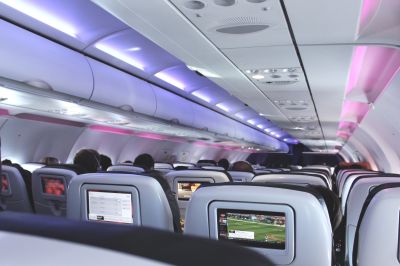Dietrich, et al. (2021) report in MMWR on laboratory modeling of SARS-CoV-2 exposure reduction: "Aircraft can hold large numbers of persons in close proximity for long periods, which can increase the risk for transmission of infectious disease. Current CDC guidelines recommend against travel for persons who have not been vaccinated against COVID-19, and a January 2021 CDC order requires masking for all persons while on airplanes. Research suggests that seating proximity on aircraft is associated with increased risk for infection with SARS-CoV-2, the virus that causes COVID-19. However, studies quantifying the benefit of specific distancing strategies to prevent transmission, such as keeping aircraft cabin middle seats vacant, are limited. Using bacteriophage MS2 virus as a surrogate for airborne SARS-CoV-2, CDC and Kansas State University (KSU) modeled the relationship between SARS-CoV-2 exposure and aircraft seating proximity, including full occupancy and vacant middle seat occupancy scenarios. Compared with exposures in full occupancy scenarios, relative exposure in vacant middle seat scenarios was reduced by 23% to 57% depending upon the modeling approach. A 23% exposure reduction was observed for a single passenger who was in the same row and two seats away from the SARS-COV-2 source, rather than in an adjacent middle seat. When quantifying exposure reduction to a full 120-passenger cabin rather than to a single person, exposure reductions ranging from 35.0% to 39.4% were predicted. A 57% exposure reduction was observed under the vacant middle seat condition in a scenario involving a three-row section that contained a mix of SARS-CoV-2 sources and other passengers. Based on this laboratory model, a vacant middle seat reduces risk for exposure to SARS-CoV-2 from nearby passengers. These data suggest that increasing physical distance between passengers and lowering passenger density could help reduce potential COVID-19 exposures during air travel. Physical distancing of airplane passengers, including through policies such as middle seat vacancy, could provide additional reductions in SARS-CoV-2 exposure risk."
Reference: Dietrich WL, et al. Laboratory Modeling of SARS-CoV-2 Exposure Reduction Through Physically Distanced Seating in Aircraft Cabins Using Bacteriophage Aerosol — November 2020MMWR. Vol. 70. April 14, 2021

Be the first to comment on "Laboratory Modeling of SARS-CoV-2 Exposure Reduction Through Physically Distanced Seating in Aircraft Cabins"